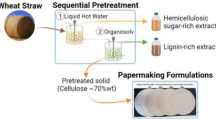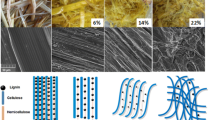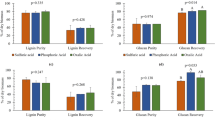Abstract
Wheat straw and okra stalk were studied to evaluate their potential use for integrated lignocellulosic biorefining. Besides chemical pulp, a wide spectrum of value-added by-products were prepared by hot-water extraction of the feedstocks under varying conditions (140 °C for 60 and 240 min and 150 °C for 25 and 100 min) prior to sulfur-free soda-anthraquinone (AQ) pulping (NaOH charge 15 and 20% by weight on o.d. feedstock for wheat straw and okra stalk, respectively, with an AQ charge of 0.05% by weight on o.d. for both feedstocks). During the hot-water pre-treatment, the most significant mass removal, respectively, 12% (w/w) and 23% (w/w) of the initial wheat straw and okra stalk was obtained at 150 °C with a treatment time of 100 min. The hydrolysates were characterized in terms of pH and the content of carbohydrates (6–20% (w/w) of the initial amount), volatile acids (acetic and formic acids), and furans. The pre-treatment stage also facilitated the delignification stage, and, for example, the pulp yields (w/w), 57% (145 °C, 15 min, and kappa number 18) and 41% (165 °C, 180 min, and kappa number 32) were obtained for the pre-treated (150 °C, P200) wheat straw and okra stalk, respectively. Results clearly indicated that both non-wood materials were suitable for this kind of biorefining approach.







Similar content being viewed by others
References
Mendes CVT, Carvalho MGVS, Baptista CMSG, Rocha JMS, Soares BIG, Sousa GDA (2009) Valorisation of hardwood hemicelluloses in the kraft pulping process by using an integrated biorefinery concept. Food Bioprod Process 87:197–207
Martin-Sampedro R, Eugenio ME, Moreno JA, Revilla E, Villar JC (2014) Integration of a kraft pulping mill into a forest biorefinery: pre-extraction of hemicellulose by steam explosion versus steam treatment. Bioresour Technol 153:236–244
Lehto JT, Alén RJ (2015) Chemical pretreatments of wood chips prior to alkaline pulping—a review of pretreatment alternatives, chemical aspects of the resulting liquors, and pulping outcomes. Bioresources 10:8604–8656
Kumar P, Barrett DM, Delwiche MJ (2009) Methods for pretreatment of lignocellulosic biomass for efficient hydrolysis and biofuel production. Ind Eng Chem Res 48:3713–3729
Gong C, Goundalkar MJ, Bujanovic BM (2012) Evaluation of different sulfur-free delignification methods for hot-water extracted hardwood. J Wood Chem Technol 32:93–104
Carvalheiro F, Duarte LC, Gírio FM (2008) Hemicellulose biorefineries: a review on biomass pretreatments. J Sci Ind Res 67:849–864
Chirat C, Lachenal D, Sanglard M (2012) Extraction of xylans from hardwood chips prior to kraft cooking. Process Biochem 47:381–385
Jönsson LJ, Alriksson B, Nilvebrant NO (2013) Bioconversion of lignocellulose: inhibitors and detoxification. Biotechnol Biofuels 6:16
Akhtar N, Gupta K, Goyal D, Goyal A (2015) Recent advances in pretreatment technologies for efficient hydrolysis of lignocellulosic biomass. Environ Prog Sustain Energy 35:489–511
Sánchez ÓJ, Cardona CA (2008) Trends in biotechnological production of fuel ethanol from different feedstocks. Bioresour Technol 99:5270–5295
Zhu JY, Pan X, Zalesny RS Jr (2010) Pretreatment of woody biomass for biofuel production: energy efficiency, technologies, and recalcitrance. Appl Microbiol Biotechnol 87:847–857
Alén R (2011) Principles of biorefining. In: Alén R (ed) Biorefining of forest resources. Paper Engineers’ Association, Helsinki, pp 55–114
Jahan MS, Rukhsana B, Baktash MM, Ahsan L, Fatehi P, Ni Y (2013) Pulping of non-wood and its related biorefinery potential in Bangladesh: a review. Curr Org Chem 17:1570–1576
Jahan MS, Shamsuzzaman M, Rahman MM, Moeiz SMI, Ni Y (2012) Effect of pre-extraction on soda-anthraquinone (AQ) pulping of rice straw. Ind Crop Prod 37:164–169
Lynd LR, Elamder RT, Wyman CE (1996) Likely features and costs of mature biomass ethanol technology. Appl Biochem Biotechnol 57:741–761
Tunc MS, van Heiningen ARP (2009) Autohydrolysis of mixed southern hardwoods: effect of P-factor. Nord Pulp Pap Res J 24:46–51
FAOSTAT (Food and Agricultural Organization of the United Nations Production Statistics), (http://fao.org), (2017) Accessed on 13 June 2017
Baw AO, Gedamu F, Dechassa N (2017) Effect of plant population and nitrogen rates on growth and yield of okra [Abelmoscus esculentus (L). Moench] in Gambella region, Western Ethiop. Afr J Agric Res 12:1395–1403
Swan B (1965) Isolation of acid-soluble lignin from the Klason lignin determination. Svensk Papperstidn 68:791–795
Pakkanen H, Alén R (2013) Alkali consumption of aliphatic carboxylic acids during alkaline pulping of wood and non-wood feedstocks. Holzforschung 67:643–650
Käkölä JM, Alén RJ, Isoaho JP, Matilainen RB (2008) Determination of low-molecular-mass aliphatic carboxylic acids and inorganic anions from kraft black liquors by ion chromatography. J Chromatogr A 1190:150–156
Paredes JJ, Jara R, Shaler SM, van Heiningen A (2008) Influence of hot water extraction on the physical and mechanical behavior of OSB. Forest Prod J 58:56–62
Kleen MA, Liitiä TM, Tehomaa MM (2011) The effect of the physical form and size of raw materials in pressurized hot water extraction of birch. In The proceedings of the 16th international symposium on wood, fiber and pulping chemistry (16th ISWFPC). Tianjin, China, pp 1013–1018
Lehto J (2015) Advanced biorefinery concept integrated to chemical pulping (doctoral thesis). Laboratory of Applied Chemistry, University of Jyväskylä, Jyväskylä
Zhang S, Yang H (2011) Effect of hot-water pre-extraction on alkaline pulping properties of wheat straw. Adv Mater Res 236:1174–1177
Yoon SH, van Heiningen A (2008) Kraft pulping and papermaking properties of hot-water pre-extracted loblolly pine in an integrated forest products biorefinery. TAPPI J 7:22–27
Tunc MS, Lawoko M, van Heiningen ARP (2010) Understanding the limitations of removal of hemicelluloses during autohydrolysis of a mixture of southern hardwoods. Bioresources 5:356–371
Arayaa F, Troncosob E, Mendoncab RT, Fareera J, Rencoretd J, Del Rio JC (2015) Structural characteristics and distribution of lignin in eucalyptus globulus pulps obtained by a combined autohydrolysis/alkaline extraction process for enzymatic saccharification of cellulose. J Chil Chem Soc 60:2954–2960
Acknowledgements
This study has been supported by the Doctoral Program in Chemistry, University of Jyväskylä. Additionally, financial support from the Finnish Cultural Foundation and Maj and Tor Nessling Foundation (Joni Lehto) is gratefully acknowledged.
Author information
Authors and Affiliations
Corresponding author
Rights and permissions
About this article
Cite this article
Ullah, S., Pakkanen, H., Lehto, J. et al. A comparable study on the hot-water treatment of wheat straw and okra stalk prior to delignification. Biomass Conv. Bioref. 8, 413–421 (2018). https://doi.org/10.1007/s13399-018-0306-x
Received:
Revised:
Accepted:
Published:
Issue Date:
DOI: https://doi.org/10.1007/s13399-018-0306-x




